Battle of Coronel - Picture
More about World War 1
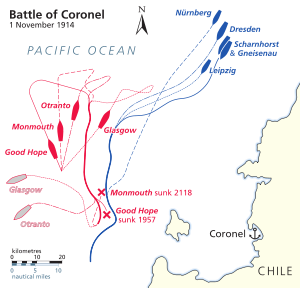
|
|
Battle of Coronel
Date
1 November 1914
Location
Pacific ocean off Coronel, Chile
Result
German victory
Date: 1 November 1914
Location: Pacific ocean off Coronel, Chile
Result: German victory
Belligerents:
: United Kingdom
Commanders and leaders:
: Sir Christopher Cradockâ€
Strength:
: 2 armoured cruisers
1 light cruiser
1 auxiliary cruiser
Casualties and losses:
: 1,570 men killed
2 armoured cruisers lost
Oceans, 1914-1917
The First World War naval Battle of Coronel took place on 1 November 1914 off the coast of central Chile near the city of Coronel. German Kaiserliche Marine forces led by Vice-Admiral Graf Maximilian von Spee met and defeated a Royal Navy squadron commanded by Rear-Admiral Sir Christopher Cradock.
The engagement probably took place as a result of a series of misunderstandings. Neither admiral expected to meet the other in full force. Once the two met, Cradock understood his orders were to fight to the end, despite the odds heavily against him. Although Spee had an easy victory, destroying two enemy armoured cruisers for just three men injured, the engagement also cost him half his supply of ammunition, which was impossible to replace. Shock at the British losses led to an immediate reaction and the sending of more ships which in turn destroyed Spee and the majority of his squadron at the Battle of the Falkland Islands.
Prelude
The Royal Navy-with assistance from other Allied navies in the far east-had captured the German colonies of Kaiser-Wilhelmsland, Yap, Nauru and Samoa early in the war, instead of searching for Vice-Admiral Maximilian von Spee's German East Asia Squadron which had abandoned its base at the German concession at Tsingtao in China once Japan entered the war on Britain's side. Eventually, recognising the German squadron's potential for commerce raiding in the Pacific the British Admiralty belatedly made its elimination a high priority but concentrated the search in the western Pacific after Spee's squadron bombarded Papeete.
On 5 October, the British learned from an intercepted radio communication of Spee's plan to prey upon shipping in the crucial trading routes along the west coast of South America. Patrolling in the area at that time was Rear-Admiral Sir Christopher Cradock's South Atlantic Squadron, consisting of thre armoured cruisers HMS Good Hope (Cradock's flagship), and HMS Monmouth, the modern light cruiser HMS Glasgow, three other light cruisers, a converted liner-HMS Otranto-and two other armed merchantmen. Cradock's force was also to have been reinforced from Mediterranean waters by the newer and more powerful armoured cruiser HMS Defence, but ultimately this ship was diverted, the old battleship HMS Canopus being ordered to join him instead.
Cradock's squadron was by no means modern, most of the crew were inexperienced with the Good Hope and Monmouth crewed mainly by reservists. Von Spee had a formidable force of five vessels (the armoured cruisers SMS Scharnhorst and Gneisenau and the light cruisers SMS Dresden, Leipzig and Nx¼rnberg), all modern ships with officers handpicked by Grand Admiral Alfred von Tirpitz. Nevertheless, Cradock was ordered simply to "be prepared to meet them in company" with no effort made to clarify what action Cradock was, or was not, expected to take should he find von Spee.
On receiving his orders, Cradock asked the Admiralty for permission to split his fleet into two forces, each able to face von Spee independently. The fleets would operate on the east and west coasts of South America to counter the possibility of von Spee slipping past Cradock and raiding into the Atlantic. The Admiralty agreed and the east coast squadron, consisting of three cruisers and two armed merchantmen was formed under Rear-Admiral A. P. Stoddart.
The remaining vessels formed Cradock’s west coast squadron which was reinforced by HMS Canopus which finally arrived on 18 October. Reprieved from its scheduled scrapping by the outbreak of war and badly in need of an overhaul, her top speed was only 12 kn (14 mph; 22 km/h). The Admiralty recognised that her slow speed meant the fleet would not be fast enough to force an engagement and also that without Canopus the fleet stood no chance against von Spee, so Cradock was told to use Canopus as "a citadel around which all our cruisers in those waters could find absolute security".
The Chief of the Admiralty War Staff-Vice-Admiral Sir Doveton Sturdee-requested additional ships be sent to reinforce Cradock, but this was vetoed by First Lord of the Admiralty, Winston Churchill and First Sea Lord of the Admiralty, Prince Louis of Battenberg. Cradock's later request for HMS Defence to rejoin him was denied on the grounds that Canopus was "sufficient reinforcement".
Opening gambit
On 22 October, Cradock cabled the Admiralty that he was going to round Cape Horn and was leaving Canopus behind to escort his colliers. Admiral John Fisher replaced Battenberg as First Sea Lord on 27 October, and the following day Fisher ordered Cradock not to engage von Spee without Canopus. He then ordered HMS Defence to reinforce Cradock.
The previous week Cradock had sent Glasgow to Montevideo to pick up any messages the Admiralty may have sent. Von Spee, having learned of the presence of Glasgow off Coronel, sailed south from Valparaxso with all five warships with the intention of destroying her. Glasgow, however, intercepted radio traffic from one of the German cruisers and informed Cradock who turned his fleet north to intercept the cruiser.
Given von Spee’s superiority in speed, firepower, efficiency and numbers, why Cradock chose to engage puzzles historians. It is known that a friend of Cradock was at that time awaiting Court-martial for failing to engage a superior enemy and he had been told by the Admiralty that his force was "sufficient". The accepted view among Cradock's colleagues was that he was "constitutionally incapable of refusing action". The more common explanation is that Cradock, knowing his mission was impossible, wanted to damage von Spee and force him to use ammunition he could not replace. On 31 October, he ordered his squadron to adopt an attacking formation. Both sides likely expected a single ship until they sighted each other at 16:40 on 1 November.
Battle

Picture - Ship movements during the Battle of Coronel. British ships are shown in red; German ships are shown in blue.
On 31 October, Glasgow entered Coronel harbour to collect messages and news from the British consul. Also in harbour was a supply ship-Gx¶ttingen-working for Spee, which immediately radioed with the news of the British ship entering harbour. Glasgow meanwhile was listening to radio traffic, which suggested that German warships were close. Matters were confused, because the German ships had been instructed to all use the same call sign, that of Leipzig. Spee decided to move his ships to Coronel, to trap Glasgow, while Admiral Cradock hurried north to catch Leipzig. Neither side realised the other's main force was nearby.
At 09:15 on 1 November, Glasgow left port to meet Cradock at noon, 40 mi (35 nmi; 64 km) west of Coronel. Seas were stormy so that it was impossible to send a boat between the ships to deliver the messages, which had to be transferred on a line floated in the sea. At 13:50, the ships formed into a line of battle 15 mi (13 nmi; 24 km) apart and started to steam north at 10 kn (12 mph; 19 km/h) searching for Leipzig. At 16:17, Leipzig, accompanied by the other German ships, spotted smoke from the British line. Von Spee ordered full speed so that Scharnhorst, Gneisenau and Leipzig were approaching the British at 20 kn (23 mph; 37 km/h), with the slower light cruisers Dresden and Nx¼rnberg some way behind.
At 16:20, Glasgow and Otranto saw smoke to the north, and then three ships at a range of 12 mi (10 nmi; 19 km). The British reversed direction, so that both fleets were moving south, and a chase began which lasted 90 minutes. Cradock was faced with a choice; he could either take his three cruisers capable of 20 kn (23 mph; 37 km/h), abandon Otranto and run from the Germans, or stay and fight with Otranto, which could only manage 16 kn (18 mph; 30 km/h). The German ships slowed at a range of 15,000 yd (14,000 m) to reorganise themselves for best positions, and to await best visibility, when the British to their west would be outlined against the setting sun.
At 17:10, Cradock decided he must fight, and drew his ships closer together. He changed course to south-east and attempted to close upon the German ships while the sun remained high. Von Spee declined to engage and turned his faster ships away, maintaining the distance between the forces which sailed roughly parallel at a distance of 14,000 yd (13,000 m). At 18:18, Cradock again attempted to close, steering directly towards the enemy, which once again turned away to a greater range of 18,000 yd (16,000 m). At 18:50, the sun set; Spee closed to 12,000 yd (11,000 m) and commenced firing.
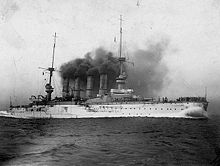
Picture - SMS Scharnhorst.
The German ships had sixteen 8.2 in (210 mm) guns of comparable range to the two 9.2 in (230 mm) guns on Good Hope. One of these was hit within five minutes of the engagement starting. Of the remaining 6 in (150 mm) guns on the British ships, most were in casemates along the sides of the ships, which continually flooded if the gun doors were opened to fire in heavy seas. The merchant cruiser Otranto-having only 4 in (100 mm) guns and being a much larger target than the other ships-retired west at full speed.
With the British 6-inch guns having insufficient range to match the German 8-inch guns, Cradock attempted to close on the German ships. By 19:30, he had reached 6,000 yd (5,500 m), but as he closed the German fire became correspondingly more accurate. Both Good Hope and Monmouth were on fire, presenting easy targets to the German gunners now that darkness had fallen, whereas the German ships had disappeared into the dark. Monmouth was first to be silenced. Good Hope continued firing, continuing to close on the German ships and receiving more and more fire. By 19:50, she had also ceased firing; subsequently her forward section exploded, then she broke apart and sank, with no one actually witnessing the sinking.
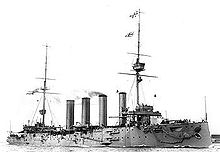
Picture - HMS Good Hope.
Scharnhorst switched firing towards Monmouth, while Gneisenau joined Leipzig and Dresden which had been engaging Glasgow. The German light cruisers had only 4.1 in (100 mm) guns, which had left Glasgow relatively unscathed, but these were now joined by the 8.2-inch guns of Gneisenau. John Luce-captain of Glasgow-determined that nothing was to be gained by staying and attempting to fight. It was noticed that each time he fired, the flash of his guns was used by the Germans to aim a new salvo, so he also ceased firing. One compartment of the ship was flooded, but she could still manage 24 kn (28 mph; 44 km/h). He returned first to Monmouth, which was now dark but still afloat. Nothing was to be done for the ship, which was sinking slowly but would attempt to beach on the Chilean coast. Glasgow turned south and departed.
There was some confusion amongst the German ships as to the fate of the two armoured cruisers, which had disappeared into the dark once they ceased firing, and a hunt began. Leipzig saw something burning, but on approaching found only wreckage. Nx¼rnberg-slower than the other German ships-arrived late at the battle and sighted Monmouth, listing and badly damaged but still moving. After pointedly directing his searchlights at the ship's ensign, an invitation to surrender-which was declined-he opened fire, finally sinking the ship. Without firm information, von Spee decided that Good Hope had escaped and called off the search at 22:15. Mindful of the reports that a British battleship was around somewhere, he turned north.
With no survivors from either Good Hope or Monmouth, 1,600 British officers and men were dead with Cradock among them. Glasgow and Otranto both escaped (the former suffering five hits and five wounded men). Just two shells had struck Scharnhorst, neither of which exploded: one 6-inch shell hit above the armour belt and penetrated to a storeroom where, in von Spee's words, "the creature just lay there as a kind of greeting." Another struck a funnel. In return, Scharnhorst had managed at least 35 hits on Good Hope, but at the expense of 422 8.2-inch shells, leaving her with 350. Four shells had struck Gneisenau, one of which nearly flooded the officers' wardroom. A shell from Glasgow struck her after turret and temporarily knocked it out. Three of Gneisenau's men were wounded; she expended 244 of her shells and had 528 left.
Aftermath
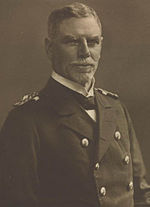
Picture - Vice-Admiral von Spee.
Von Spee commented afterward on the British tactics. He had been misinformed that the battleship Canopus sighted in the area was a relatively modern Queen-class ship, whereas it was a similar appearing, old and barely seaworthy Canopus-class battleship, but nonetheless had four 12 in (300 mm) guns and ten 6-inch guns. Von Spee believed he would have lost the engagement had all the British ships been together. Despite his victory he was pessimistic of the real harm done to the British navy, and also of his own chances of survival. Cradock had been less convinced of the value of Canopus, being too slow at 12 knots to allow his other ships freedom of movement and manned only by inexperienced reservists.
The official explanation of the defeat as presented to the House of Commons by Winston Churchill stated: "feeling he could not bring the enemy immediately to action as long as he kept with Canopus, he decided to attack them with his fast ships alone, in the belief that even if he himself were destroyed... he would inflict damage on them which ...would lead to their certain subsequent destruction."
On 3 November, Scharnhorst, Gneisenau and Nx¼rnberg entered Valparaiso harbour and were welcomed as heroes by the German population. Von Spee refused to join in the celebrations: presented with a bunch of flowers he commented, "these will do nicely for my grave". He was to die with most of the men on his ships approximately one month later at the Battle of the Falkland Islands, on 8 December 1914.
Lines of communication

Picture - Churchill and Fisher
On 30 October, before the battle but due to communications delays too late to have any effect, Admiral Jacky Fisher was re-appointed First Sea Lord, replacing Battenberg. Battenberg and Churchill had been considerably preoccupied with fighting to retain Battenberg, a German prince, as first sea lord against widespread concerns that the senior British Admiral was running a war against the land of his birth. Battenberg was a proven and reliable admiral, but eventually had to be replaced in the face of public opinion. However, the whole crisis drew the attention of the most senior officers of the admiralty away from events in South America. Churchill later claimed that if he had not been distracted, he would have questioned more deeply the intentions of his admiral at sea.
A signal from Cradock was received by Churchill on 27 October, advising his intention to leave Canopus behind, because of her slow speed, and as previously instructed to take his remaining ships in search of Spee. He re-stated that he was still expecting reinforcements in the form of HMS Defence, which he had previously been told was coming, and that he had given orders for her to follow him as soon as possible. Although Defence had once been sent to reinforce Cradock, it had then been recalled part way, returned to the Mediterranean and then been sent again to form part of a new squadron patrolling the eastern coast of South America. A misunderstanding had arisen between Cradock and the admiralty over how ships were to be assigned and used. Cradock believed he was expected to advance against von Spee with those forces he had, whereas the Admiralty expected him to exercise caution, centering upon Canopus for defence, and merely to scout the enemy or take advantage of any situation where he might come across part of the enemy force. Churchill replied to the signal telling Cradock that Defence was to remain on the east coast and that Cradock was considered to have sufficient forces for his task, making no comment about his plan to abandon Canopus. Churchill had passed on the message to the admiralty staff saying he did not properly understand what Cradock intended.
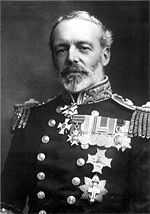
Picture - Rear-Admiral Cradock.
Cradock probably received Churchill's reply on 1 November with the messages collected by Glasgow at Coronel, giving him time to read it before the battle. Thus Cradock would have taken the message as final confirmation that he was doing what was expected. Departing from Stanley he had left behind a letter to be forwarded to Admiral of the Fleet Sir Hedworth Meux in the event of his death. In this, he commented that he did not intend to suffer the fate of Rear-Admiral Troubridge, who in August had been court-martialled for failing to engage the enemy despite the odds being against him, during the pursuit of Goeben and Breslau. In Troubridge's case, the German ships had slipped past him and escaped, and it was possible that von Spee might do the same, rounding the Horn and heading for Germany if he did not intervene. The governor of the Falklands reported that Cradock had not expected to survive, as did the governor's aide. Luce reported that "Cradock was constitutionally incapable of refusing or even postponing action if there was the smallest chance of success".
On 3 November, Fisher in London received news from Valparaiso that Spee had been sighted. He urgently gave orders for Defence to join Cradock, and stressing the need to keep Canopus together with the other ships. On 4 November, German reports of the battle started to reach London.
British response
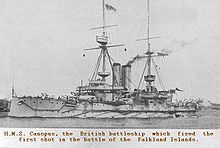
Picture - HMS Canopus. Beached at Stanley, she was later re-floated and took part in the Gallipoli Campaign.
This was Britain's first naval defeat since the Battle of Lake Champlain in the War of 1812 and the first of a British naval squadron since the Battle of Grand Port in 1810. Six weeks earlier, a German submarine had sunk three British cruisers patrolling the English Channel.
Once news of the scale of the British defeat, and its consequent humiliation, reached the British Admiralty in London, a new naval force was assembled under Vice-Admiral Sturdee. This found and destroyed Spee's force at the Battle of the Falkland Islands.
Glasgow escaping the battle steamed south for three days at 20 knots passing through the Straits of Magellan. Canopus-warned by Glasgow's messages-turned about and headed back at the best speed she could manage, 9 kn (10 mph; 17 km/h). On 6 November, the two ships met and proceeded slowly towards the Falkland isles. Twice during the voyage Canopus had to report that the ship was not under control. After coaling, both ships were ordered north, but again Canopus broke down. She was finally ordered to be beached in the inner part of Stanley Harbour, where she could serve as a defensive battery.
Otranto steamed 41 ft 6 in (12.65 m)200 miles out into the Pacific ocean, before turning south and passing around Cape Horn. On 4 November the admiralty issued orders for the surviving ships to move to the Abrolhos Rocks, where a new force was being assembled. Rear-Admiral Archibald Stoddart-with the armoured cruisers HMS Carnarvon and Cornwall-was to meet them there and await the arrival of Defence. Sturdee was ordered to travel with the battlecruisers HMS Invincible and Inflexible-then attached to the Grand Fleet in the North Sea-to command a new squadron with clear superiority over von Spee.
Footnotes
Reference list
Robert Massie (2004). Castles of Steel: Britain, Germany, and the Winning of the Great War at Sea. London: Jonathan Cape. ISBN 0224040928.
Barrie Pitt (1960). Coronel and Falkland. London: Cassell.
Arthur Marder (1961-1970). From the Dreadnought to Scapa Flow (5 Vols). London: Oxford University Press.
"Good Hope Sunk". The Times (40689): pp. 9. 1914-11-07
Winston Churchill (1923-1927). The World Crisis (four Volumes). London: Thornton Butterworth.
Gerhard Wiechmann (2004). Vom Auslandsdienst in Mexiko zur Seeschlacht von Coronel. Kapitx¤n Karl von Schx¶nberg. Reisetagebuch 1913-1914 (From foreign service in Mexiko to the sea battle of Coronel. Captain Karl von Schx¶nberg. Voyage diary 1913-1914). Bochum: Dr. Winkler Verlag. ISBN 3899110366. ISBN 978-3899110364.
Norman Friedman and A.D. Baker (2008). Naval Firepower: Battleship Guns and Gunnery in the Dreadnought Era. Naval Press Institute. ISBN 1591145554.
Arthur Herman (2005). To Rule the Waves: How the British Navy Shaped the Modern World. New York: Harper Perennial. ISBN 9780060534240.
More aircraft.
Source: WikiPedia